The Development of Thematic Core Collections in Cassava Based on Yield, Disease Resistance, and Root Quality Traits
Abstract
1. Introduction
2. Results
2.1. Cassava Thematic Collections
2.2. Phenotypic Variation in Cassava Thematic Collections
2.3. An Analysis of the Phenotypic Diversity of the Thematic Collections
2.4. Genetic Diversity of the Cassava Thematic Collections Using Molecular Markers
2.5. The Validation of Thematic Collections
3. Discussion
3.1. The Formation and Diversity of the Cassava Thematic Collections
3.2. A Comprehensive Representation of Genetic Variation
3.3. Unlocking Practical Utility: The Significance of Thematic Cassava Collections
4. Materials and Methods
4.1. A Comprehensive Data Collection of the Morpho-Agronomic Traits
4.1.1. Yield Traits
- Plant height (Pl.H), measured from the ground to the plant’s meristem;
- Plant architecture (Pl.A), evaluated using a 1–5 rating scale: 1 = excellent architecture (no branching or erect stems), 2 = good architecture (branching above 1.60 m or low branching with at least 1.6 m of erect stems), 3 means moderate architecture (branching above 1.20 m or low branching with at least 1.2 m of erect stems), 4 = poor architecture (branching above 0.80 m or low branching with at least 0.80 m of erect stems), and 5 = very poor architecture (highly branched clones with less than 0.80 m of erect stems);
- Plant type (Pl.T), assessed using a 1–5 rating scale: 1 = compact, 2 = open plant, 3 = umbrella-like, and 4 stands for cylindrical;
- Shoot yield (ShY), measured in t.ha−1 as the total weight of above-ground parts, including leaves, petioles, and stems;
- Marketable fresh root yield (C.FRY), measured in t.ha−1 and characterized by roots with an absence of pest and disease symptoms and the standard size and shape of the genotype;
- Unmarketable fresh root yield (NC.FRY), measured in t.ha−1 as the rest of C.FRY;
- Total fresh root yield (T.FRY), assessed as C.FRY + NC.FRY in t.ha−1;
- Dry matter content (DMC), expressed as a percentage and measured using the hydrostatic balance method [43];
- Starch content (StC), expressed as a percentage and measured by extracting starch from the roots [44];
- Dry root yield (DRY), measured in t.ha−1 and obtained by multiplying T.FRY and DMC;
- Harvest index (HI), assessed as T.FRY/(T.FRY + ShY);
- Cortex thickness (Ro.CT), measured in millimeters (mm);
- The presence of a peduncle (Ro.Pe), assessed on a scale where 0 = sessile, 3 = pedunculated, and 5 = a mixture of sessile and pedunculated roots;
- Root constriction (Ro.Co), assessed using a 1–3 rating scale: 1 = few or no constrictions, 2 = some constrictions, and 3 = many constrictions;
- Average root length (Ro.Le), measured in centimeters (cm) from the base to the tip;
- Average root diameter (Ro.Di), measured in millimeters (mm) at the central part of the roots;
- Easy root peeling (Ro.EP), evaluated at harvest time on a rating scale: 3 = easy peeling, 5 = medium peeling, and 7 = difficult peeling;
- Leaf retention (Pl.LR), assessed using a rating scale: 1 = less than 5% leaf retention, 2 = 6–15% leaf retention, 3 = 16–30% leaf retention, 4 = 31–50% leaf retention, and 5 = >50% of leaf retention;
- Plant vigor at 1.5 months (Pl.V1.5M), assessed using a rating scale: 1 = low vigor, 3 = intermediate vigor, and 5 = high vigor;
- Plant vigor at 12 months (Pl.V12M), similar to Pl.V1.5M;
- The average number of roots per plant (Ro.NP).
4.1.2. Resistance to Pests and Diseases
- Mite severity (P.MS), rated as follows: 0 = no damage; 1 = some white–yellow spots extending to the base of leaves on the apical shoot; 2 = moderate yellow spots on all leaves; 3 = abundant spots on middle-third leaves, slight apical shoot deformation; 4 = severe leaf deformation on apical shoot, whitish appearance, some defoliation, and stem with yellow spots; 5 = highly twisted apical shoots /severe stem spots; 6 = dry apical shoots, leafless, or dead;
- Anthracnose severity (Colletotrichum sp.) (D.AntS), rated as follows: 1 = no symptoms; 2 = small or old cankers on the lower half of the plant; 3 = deep cankers on the upper half of the plant; 4 = deep cankers with sporulation, leaf distortion, wilting, and apex drying; 5 = apical death or plant death;
- Bacterial blight severity (Xanthomonas axonopodis pv. manihotis) (D.CBB), scored as follows: 1 = no symptoms, 2 = only foliar symptoms (angular leaf spot), 3 = dark necrotic lesions on stems or petioles, 4 = severe leaf symptoms and/or necrotic lesions with gum exudation, 5 = complete leaf loss with apical death or plant death;
- Brown spot severity (Passalora henningsii) (D.BrLS), scored as follows: 0 = no symptoms; 1 = mild symptoms on the lower third leaves; 2 = leaf spots on lower leaves and yellowing on a few affected leaves; 3 = leaf spots on lower and middle leaves, yellowing on most affected leaves; 4 = leaf spots across the entire plant, lower leaf shedding; 5 = complete plant defoliation;
- Blight leaf spot severity (Passalora viçosae) (D.BlLS), evaluated similar to D.BrLS;
- Rust severity (Uromyces manihotis) (D.RS), scored as follows: 0 = no pustules or damage on stems and leaves, 1 = a few pustules without branch drying, 2 = many pustules with branch drying;
- Frogskin severity (virus and phytoplasma complex) (D.FS), assessed as 0 = no symptoms on roots; 1 = few roots with corky epidermis 2 = many roots with a corky epidermis, deep cracks, or absence of tuberous root production;
- Root rot severity (Phytophthora sp., Pythium sp., Phytopythium sp.), dry Rot (Fusarium sp.), and black rot (Neoscytalidium hyalinum and Lasiodiplodia sp.) (D.RRS), rated as follows: 0 = no root rot, 1 = roots up to 25% with root rot, 2 = roots with more than 26% having root rot.
4.1.3. Root Quality Traits
- Root cooking time (Ro.CoT), measured at intervals of 15, 20, 25, 30, and 40 min, according to [45];
- Root Pulp Color (Ro.PC), categorized as follows: 1 = white, 2 = cream, 3 = yellow, 4 = pink, 5 = orange;
- Root skin color (Ro.SC), rated as follows: 1 = white, 2 = yellow, 3 = light brown, 4 = dark brown;
- Root cortex color (Ro.CC), scored as 1 = white or cream, 2 = yellow, 3 = pink, and 4 = purple;
- Cooked root friability (Ro.RF), which is friability evaluated after cooking, based on [46]: 1 = very cohesive, no cracks; 2 = cohesive roots with a cracked center; 3 = friable, with the center cracked and surface partially cracked; 4 = highly friable, with extensive cracking in both center and surface;
- Hydrogen cyanide content (Ro.HCN), assessed using the picrate method as detailed by [25];
- Total carotenoid content (Ro.TCC): the concentration of total carotenoids in roots determined following the methodology outlined by [27].
4.2. Data Analysis
4.3. Development of the Thematic Collections for Cassava Germplasm
4.4. Kinship Analysis and Overlap Assessment among Cassava Accessions and Thematic Collections
4.5. The Genetic Parameters of the Thematic Collections
4.6. The Phenotypic and Molecular Diversity of the Cassava Thematic Collections
5. Conclusions
Supplementary Materials
Author Contributions
Funding
Data Availability Statement
Conflicts of Interest
References
- Ceballos, H.; Rojanaridpiched, C.; Phumichai, C.; Becerra, L.A.; Kittipadakul, P.; Iglesias, C.; Gracen, V.E. Excellence in Cassava Breeding: Perspectives for the Future. Crop Breed. Genet. Genom. 2020, 2, e200008. [Google Scholar] [CrossRef][Green Version]
- Adeyemo, O.S.; Chavarriaga, P.; Tohme, J.; Fregene, M.; Davis, S.J.; Setter, T.L. Overexpression of Arabidopsis FLOWERING LOCUS T (FT) Gene Improves Floral Development in Cassava (Manihot esculenta, Crantz). PLoS ONE 2017, 12, e0181460. [Google Scholar] [CrossRef] [PubMed]
- Instituto Brasileiro de Geografia e Estatística—IBGE Levantamento Sistemático Da Produção Agrícola. 2022. Available online: https://sidra.ibge.gov.br/tabela/ (accessed on 15 March 2022).
- Oliveira, E.J.; Fukuda, W.M.G.; de Oliveira, S.A.S.; Ringenberg, R.; Silva, M.R.; Souza, A.d.S.; Silva, A.L.L.; Filho, M.d.S.O.; Faria, M.L.; Silva, R.d.J.S. BRS Novo Horizonte—A New Cassava Variety for Industrial Use. Crop Breed. Appl. Biotechnol. 2020, 20, e28882028. [Google Scholar] [CrossRef]
- Vieira, E.A.; Fialho, J.d.F.; de Julio, L.; Carvalho, L.J.C.B.; Corte, J.L.D.; Rinaldi, M.M.; de Oliveira, C.M.; Fernandes, F.D.; Anjos, J.d.R.N.D. Brs 400 and Brs 401, Sweet Cassava Cultivars with Pink Roots Developed by Participatory Breeding. Crop Breed. Appl. Biotechnol. 2019, 19, 501–504. [Google Scholar] [CrossRef]
- Boukar, O.; Bhattacharjee, R.; Fatokun, C.; Kumar, P.L.; Gueye, B. 6—Cowpea. In Genetic and Genomic Resources of Grain Legume Improvement; Singh, M., Upadhyaya, H.D., Bisht, I.S., Eds.; Elsevier: Oxford, UK, 2013; pp. 137–156. ISBN 978-0-12-397935-3. [Google Scholar]
- Frankel, O.; Brown, A. Plant Genetic Resources Today: A Critical Appraisal. In Crop Genetic Resources: Conservation and Evaluation; Singh, M., Upadhyaya, H.D., Bisht, I.S., Eds.; Elsevier: Oxford, UK, 1984; pp. 241–256. [Google Scholar]
- Pessoa-Filho, M.; Rangel, P.H.; Ferreira, M.E. Extracting Samples of High Diversity from Thematic Collections of Large Gene Banks Using a Genetic-Distance Based Approach. BMC Plant Biol. 2010, 10, 127. [Google Scholar] [CrossRef]
- Boczkowska, M.; Łapiński, B.; Kordulasińska, I.; Dostatny, D.F.; Czembor, J.H. Promoting the Use of Common Oat Genetic Resources through Diversity Analysis and Core Collection Construction. PLoS ONE 2016, 11, e0167855. [Google Scholar] [CrossRef] [PubMed]
- El Bakkali, A.; Haouane, H.; Moukhli, A.; Costes, E.; Van Damme, P.; Khadari, B. Construction of Core Collections Suitable for Association Mapping to Optimize Use of Mediterranean Olive (Olea europaea L.) Genetic Resources. PLoS ONE 2013, 8, e61265. [Google Scholar] [CrossRef] [PubMed][Green Version]
- Guo, Y.; Li, Y.; Hong, H.; Qiu, L.-J. Establishment of the Integrated Applied Core Collection and Its Comparison with Mini Core Collection in Soybean (Glycine max). Crop J. 2014, 2, 38–45. [Google Scholar] [CrossRef]
- Upadhyaya, H.D.; Vetriventhan, M.; Asiri, A.M.; Azevedo, V.C.R.; Sharma, H.C.; Sharma, R.; Sharma, S.P.; Wang, Y. Multi-Trait Diverse Germplasm Sources from Mini Core Collection for Sorghum Improvement. Agriculture 2019, 9, 121. [Google Scholar] [CrossRef]
- Upadhyaya, H.; Furman, B.; Dwivedi, S.; Udupa, S.; Laxmipathi Gowda, C.; Baum, M.; Crouch, J.; Buhariwalla, H.; Sube, S. Development of a Composite Collection for Mining Germplasm Possessing Allelic Variation for Beneficial Traits in Chickpea. Plant Genet. Resour. 2006, 4, 13–19. [Google Scholar] [CrossRef]
- Perez-Fons, L.; Ovalle, T.M.; Maruthi, M.N.; Colvin, J.; Lopez-Lavalle, L.A.B.; Fraser, P.D. The Metabotyping of an East African Cassava Diversity Panel: A Core Collection for Developing Biotic Stress Tolerance in Cassava. PLoS ONE 2020, 15, e0242245. [Google Scholar] [CrossRef] [PubMed]
- Wang, C.; Hu, S.; Gardner, C.; Lübberstedt, T. Emerging Avenues for Utilization of Exotic Germplasm. Trends Plant Sci. 2017, 22, 624–637. [Google Scholar] [CrossRef]
- Oliveira, E.J.; Ferreira, C.F.; Santos, V.S.; Oliveira, G.a.F. Development of a Cassava Core Collection Based on Single Nucleotide Polymorphism Markers. Genet Mol Res 2014, 13, 6472–6485. [Google Scholar] [CrossRef] [PubMed]
- dos Santos, C.C.; de Andrade, L.R.B.; do Carmo, C.D.; de Oliveira, E.J. Development of Cassava Core Collections Based on Morphological and Agronomic Traits and SNPS Markers. Front. Plant Sci. 2023, 14, 1250205. [Google Scholar] [CrossRef] [PubMed]
- Moura, E.; Neto, J.; Sampaio, J.; da Silva, D.T.; Ramalho, G. Identification of Duplicates of Cassava Accessions Sampled on the North Region of Brazil Using Microsatellite Markers. Acta Amaz. 2013, 43, 461–467. [Google Scholar] [CrossRef]
- Egbadzor, K.F.; Ofori, K.; Yeboah, M.; Aboagye, L.M.; Opoku-Agyeman, M.O.; Danquah, E.Y.; Offei, S.K. Diversity in 113 Cowpea [Vigna unguiculata (L) Walp] Accessions Assessed with 458 SNP Markers. Springerplus 2014, 3, 541. [Google Scholar] [CrossRef] [PubMed]
- Moura, E.F.; Sousa, N.R.; Moura, M.F.; Dias, M.C.; Souza, E.D.; de Farias Neto, J.T.; Sampaio, J.E. Molecular Characterization of Accessions of a Rare Genetic Resource: Sugary Cassava (Manihot esculenta Crantz) from Brazilian Amazon. Genet. Resour. Crop Evol. 2016, 63, 583–593. [Google Scholar] [CrossRef]
- de Albuquerque, H.Y.G.; de Oliveira, E.J.; Brito, A.C.; de Andrade, L.P.; do Carmo, C.D.; Morgante, C.V.; Vieira, E.A.; Moura, E.F.; Faleiro, F.G. Identification of Duplicates in Cassava Germplasm Banks Based on Single-Nucleotide Polymorphisms (SNPs). Sci. Agric. 2019, 76, 328–336. [Google Scholar] [CrossRef]
- Liu, W.; Shahid, M.Q.; Bai, L.; Lu, Z.; Chen, Y.; Jiang, L.; Diao, M.; Liu, X.; Lu, Y. Evaluation of Genetic Diversity and Development of a Core Collection of Wild Rice (Oryza rufipogon Griff.) Populations in China. PLoS ONE 2015, 10, e0145990. [Google Scholar] [CrossRef]
- Belaj, A.; Dominguez-García, M.d.C.; Atienza, S.G.; Martín Urdíroz, N.; De la Rosa, R.; Satovic, Z.; Martín, A.; Kilian, A.; Trujillo, I.; Valpuesta, V.; et al. Developing a Core Collection of Olive (Olea europaea L.) Based on Molecular Markers (DArTs, SSRs, SNPs) and Agronomic Traits. Tree Genet. Genomes 2012, 8, 365–378. [Google Scholar] [CrossRef]
- Thachuk, C.; Crossa, J.; Franco, J.; Dreisigacker, S.; Warburton, M.; Davenport, G.F. Core Hunter: An Algorithm for Sampling Genetic Resources Based on Multiple Genetic Measures. BMC Bioinform. 2009, 10, 243. [Google Scholar] [CrossRef] [PubMed]
- Bradbury, M.G.; Egan, S.V.; Bradbury, J.H. Picrate Paper Kits for Determination of Total Cyanogens in Cassava Roots and All Forms of Cyanogens in Cassava Products. J. Sci. Food Agric. 1999, 79, 593–601. [Google Scholar] [CrossRef]
- Bradbury, J.H.; Holloway, W.D. Chemistry of Tropical Root Crops: Significance for Nutrition and Agriculture in the Pacific. In Monographs; Australian Centre for International Agricultural Research: Canberra, Australia, 1988. [Google Scholar]
- de Carvalho, R.R.B.; Bandeira E Sousa, M.; de Oliveira, L.A.; de Oliveira, E.J. Phenotypic Diversity and Selection in Biofortified Cassava Germplasm for Yield and Quality Root Traits. Euphytica 2022, 218, 173. [Google Scholar] [CrossRef] [PubMed]
- de Carvalho, R.R.B.; Marmolejo Cortes, D.F.; Bandeira E Sousa, M.; de Oliveira, L.A.; de Oliveira, E.J. Image-Based Phenotyping of Cassava Roots for Diversity Studies and Carotenoids Prediction. PLoS ONE 2022, 17, e0263326. [Google Scholar] [CrossRef] [PubMed]
- Bechoff, A.; Tomlins, K.; Fliedel, G.; Becerra Lopez-Lavalle, L.A.; Westby, A.; Hershey, C.; Dufour, D. Cassava Traits and End-User Preference: Relating Traits to Consumer Liking, Sensory Perception, and Genetics. Crit. Rev. Food Sci. Nutr. 2018, 58, 547–567. [Google Scholar] [CrossRef] [PubMed]
- Tran, T.; Zhang, X.; Ceballos, H.; Moreno, J.L.; Luna, J.; Escobar, A.; Morante, N.; Belalcazar, J.; Becerra, L.A.; Dufour, D. Correlation of Cooking Time with Water Absorption and Changes in Relative Density during Boiling of Cassava Roots. Int. J. Food Sci. Technol. 2021, 56, 1193–1205. [Google Scholar] [CrossRef] [PubMed]
- de Andrade, L.R.B.; Sousa, M.B.E.; Oliveira, E.J.; de Resende, M.D.V.; Azevedo, C.F. Cassava Yield Traits Predicted by Genomic Selection Methods. PLoS ONE 2019, 14, e0224920. [Google Scholar] [CrossRef]
- de Andrade, L.R.B.; Sousa, M.B.E.; Wolfe, M.; Jannink, J.-L.; de Resende, M.D.V.; Azevedo, C.F.; de Oliveira, E.J. Increasing Cassava Root Yield: Additive-Dominant Genetic Models for Selection of Parents and Clones. Front. Plant Sci. 2022, 13, 1071156. [Google Scholar] [CrossRef]
- Bofarhe, O.; Bofarhe, J.; Segun, A.; Ayandiji, A.; Demeji, O.; James, O. Detection and Classification of Cassava Diseases Using Machine Learning. Int. J. Comput. Sci. Softw. Eng. 2019, 8, 2409–4285. [Google Scholar]
- Zinsou, V.; Wydra, K.; Ahohuendo, B.; Hau, B. Genotype × Environment Interactions in Symptom Development and Yield of Cassava Genotypes with Artificial and Natural Cassava Bacterial Blight Infections. Eur. J. Plant Pathol. 2005, 111, 217–233. [Google Scholar] [CrossRef]
- Silva, P.R.O.; de Jesus, O.N.; Bragança, C.A.D.; Haddad, F.; Amorim, E.P.; Ferreira, C.F. Development of a Thematic Collection of Musa Spp Accessions Using SCAR Markers for Preventive Breeding against Fusarium oxysporum f. Sp Cubense Tropical Race 4. Genet. Mol. Res. 2016, 15, 15017765. [Google Scholar] [CrossRef] [PubMed]
- Jombart, T.; Devillard, S.; Balloux, F. Discriminant Analysis of Principal Components: A New Method for the Analysis of Genetically Structured Populations. BMC Genet. 2010, 11, 94. [Google Scholar] [CrossRef] [PubMed]
- Wang, J.; McClean, P.E.; Lee, R.; Goos, R.J.; Helms, T. Association Mapping of Iron Deficiency Chlorosis Loci in Soybean (Glycine max L. Merr.) Advanced Breeding Lines. Theor. Appl. Genet. 2008, 116, 777–787. [Google Scholar] [CrossRef] [PubMed]
- Collard, B.C.Y.; Jahufer, M.Z.Z.; Brouwer, J.B.; Pang, E.C.K. An Introduction to Markers, Quantitative Trait Loci (QTL) Mapping and Marker-Assisted Selection for Crop Improvement: The Basic Concepts. Euphytica 2005, 142, 169–196. [Google Scholar] [CrossRef]
- Esuma, W.; Herselman, L.; Labuschagne, M.; Ramu, P.; Lu, F.; Baguma, Y.; Buckler, E.; Kawuki, R. Genome-Wide Association Mapping of Provitamin A Carotenoid Content in Cassava. Euphytica 2016, 212, 97–110. [Google Scholar] [CrossRef]
- Wolfe, M.D.; Rabbi, I.Y.; Egesi, C.; Hamblin, M.; Kawuki, R.; Kulakow, P.; Lozano, R.; Carpio, D.P.D.; Ramu, P.; Jannink, J.-L. Genome-Wide Association and Prediction Reveals Genetic Architecture of Cassava Mosaic Disease Resistance and Prospects for Rapid Genetic Improvement. Plant Genome 2016, 9. [Google Scholar] [CrossRef]
- Rabbi, I.Y.; Kayondo, S.I.; Bauchet, G.; Yusuf, M.; Aghogho, C.I.; Ogunpaimo, K.; Uwugiaren, R.; Smith, I.A.; Peteti, P.; Agbona, A.; et al. Genome-Wide Association Analysis Reveals New Insights into the Genetic Architecture of Defensive, Agro-Morphological and Quality-Related Traits in Cassava. Plant Mol. Biol. 2022, 109, 195–213. [Google Scholar] [CrossRef]
- Fukuda, C.M.G.; Guevara Gómez, C.L.; Kawuki, R.S.; Ferguson, M.E. Selected Morphological and Agronomic Descriptors for the Characterization of Cassava; International Institute of Tropical Agriculture: Ibadan, Nigeria, 2010; ISBN 978-978-131-347-9. [Google Scholar]
- Kawano, K.; Fukuda, W.; Cenpukdee, U. Genetic and Environmental Effects on Dry Matter Content of Cassava Root. Crop Sci. 1987, 27, 69–74. [Google Scholar] [CrossRef]
- Vasconcelos, L.M.; Brito, A.C.; Carmo, C.D.; Oliveira, P.H.G.A.; Oliveira, E.J. Phenotypic Diversity of Starch Granules in Cassava Germplasm. Genet. Mol. Res. 2017, 16, gmr16029276. [Google Scholar] [CrossRef]
- Talma, S.V.; Almeida, S.B.; Lima, R.M.P.; Vieira, H.D.; Bebert, P.A. Tempo de cozimento e textura de raízes de mandioca. Braz. J. Food Technol. 2013, 16, 133–138. [Google Scholar] [CrossRef]
- Franck, H.; Christian, M.; Noël, A.; Brigitte, P.; Joseph, H.D.; Cornet, D.; Mathurin, N.C. Effects of Cultivar and Harvesting Conditions (Age, Season) on the Texture and Taste of Boiled Cassava Roots. Food Chem. 2011, 126, 127–133. [Google Scholar] [CrossRef]
- R Core Team. R: A Language and Environment for Statistical Computing; R Foundation for Statistical Computing: Vienna, Austria, 2022. [Google Scholar]
- Ogbonna, A.C.; Braatz de Andrade, L.R.; Mueller, L.A.; de Oliveira, E.J.; Bauchet, G.J. Comprehensive Genotyping of a Brazilian Cassava (Manihot esculenta Crantz) Germplasm Bank: Insights into Diversification and Domestication. Theor. Appl. Genet. 2021, 134, 1343–1362. [Google Scholar] [CrossRef]
- Bradbury, P.J.; Zhang, Z.; Kroon, D.E.; Casstevens, T.M.; Ramdoss, Y.; Buckler, E.S. TASSEL: Software for Association Mapping of Complex Traits in Diverse Samples. Bioinformatics 2007, 23, 2633–2635. [Google Scholar] [CrossRef] [PubMed]
- Browning, B.L.; Browning, S.R. Genotype Imputation with Millions of Reference Samples. Am. J. Hum. Genet. 2016, 98, 116–126. [Google Scholar] [CrossRef] [PubMed]
- Zheng, X.; Levine, D.; Shen, J.; Gogarten, S.M.; Laurie, C.; Weir, B.S. A High-Performance Computing Toolset for Relatedness and Principal Component Analysis of SNP Data. Bioinformatics 2012, 28, 3326–3328. [Google Scholar] [CrossRef] [PubMed]
- Cohen, J. A Coefficient of Agreement for Nominal Scales. Educ. Psychol. Meas. 1960, 20, 37–46. [Google Scholar] [CrossRef]
- Goudet, J. Hierfstat, a Package for r to Compute and Test Hierarchical F-Statistics. Mol. Ecol. Notes 2005, 5, 184–186. [Google Scholar] [CrossRef]
- Berends, M.; Luz, C.; Friedrich, A.; Sinha, B.; Albers, C.; Glasner, C. AMR—An R Package for Working with Antimicrobial Resistance Data. J. Stat. Softw. 2021, 104, 1–32. [Google Scholar] [CrossRef]
- Blighe, K.; Lun, A. PCAtools: Everything Principal Components Analysis. R package version 2.12.0. 2023. Available online: https://github.com/kevinblighe/PCAtools (accessed on 17 August 2023).


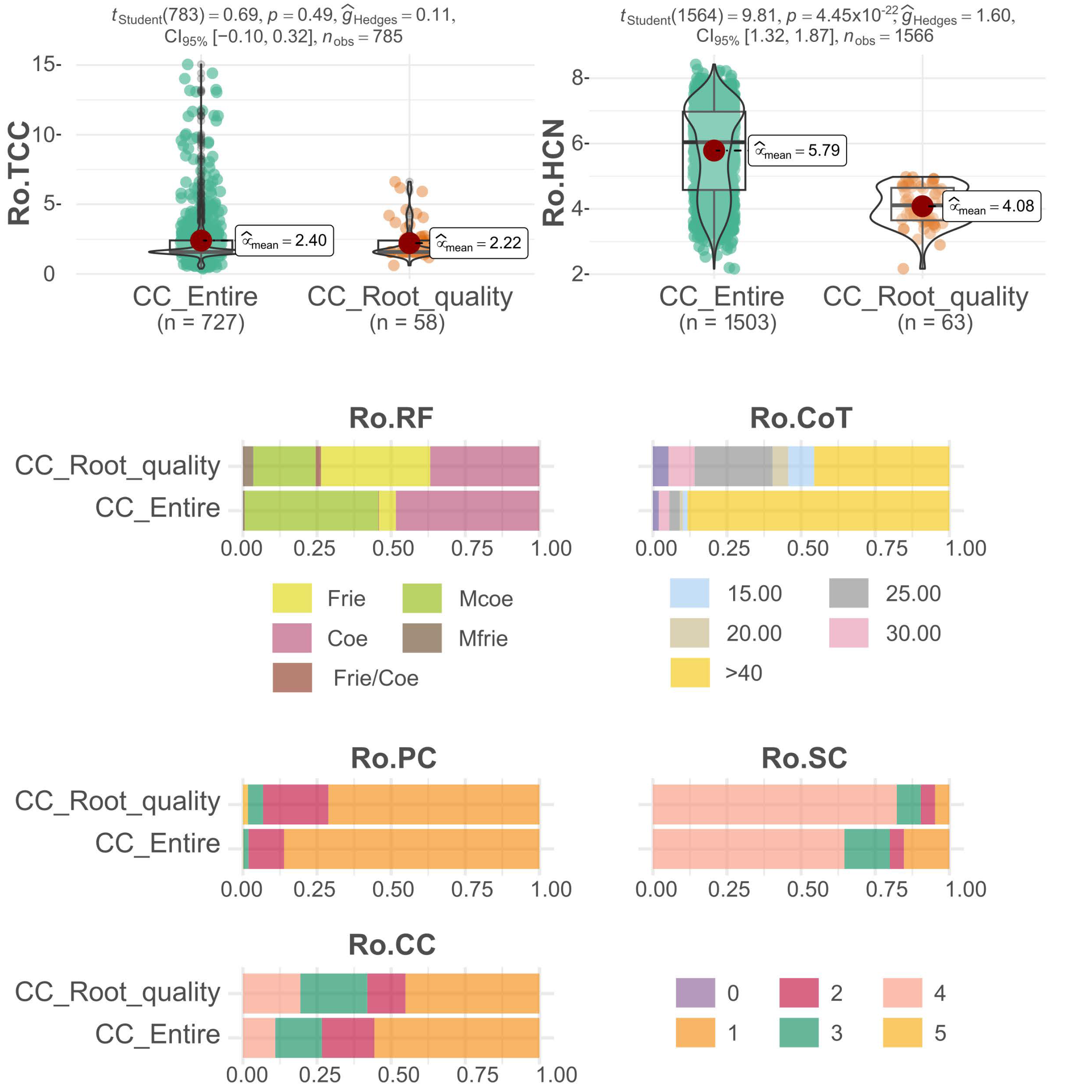
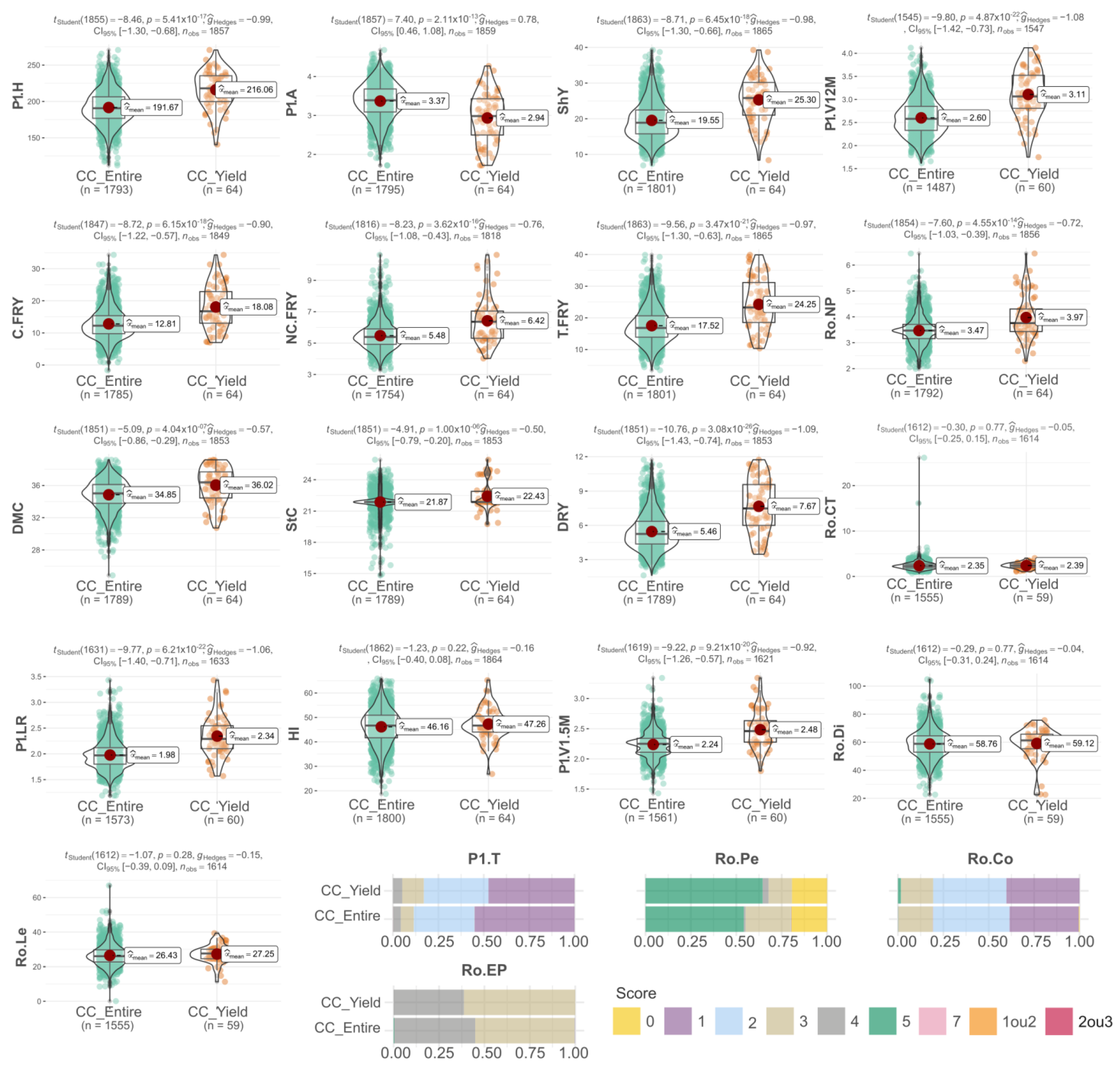
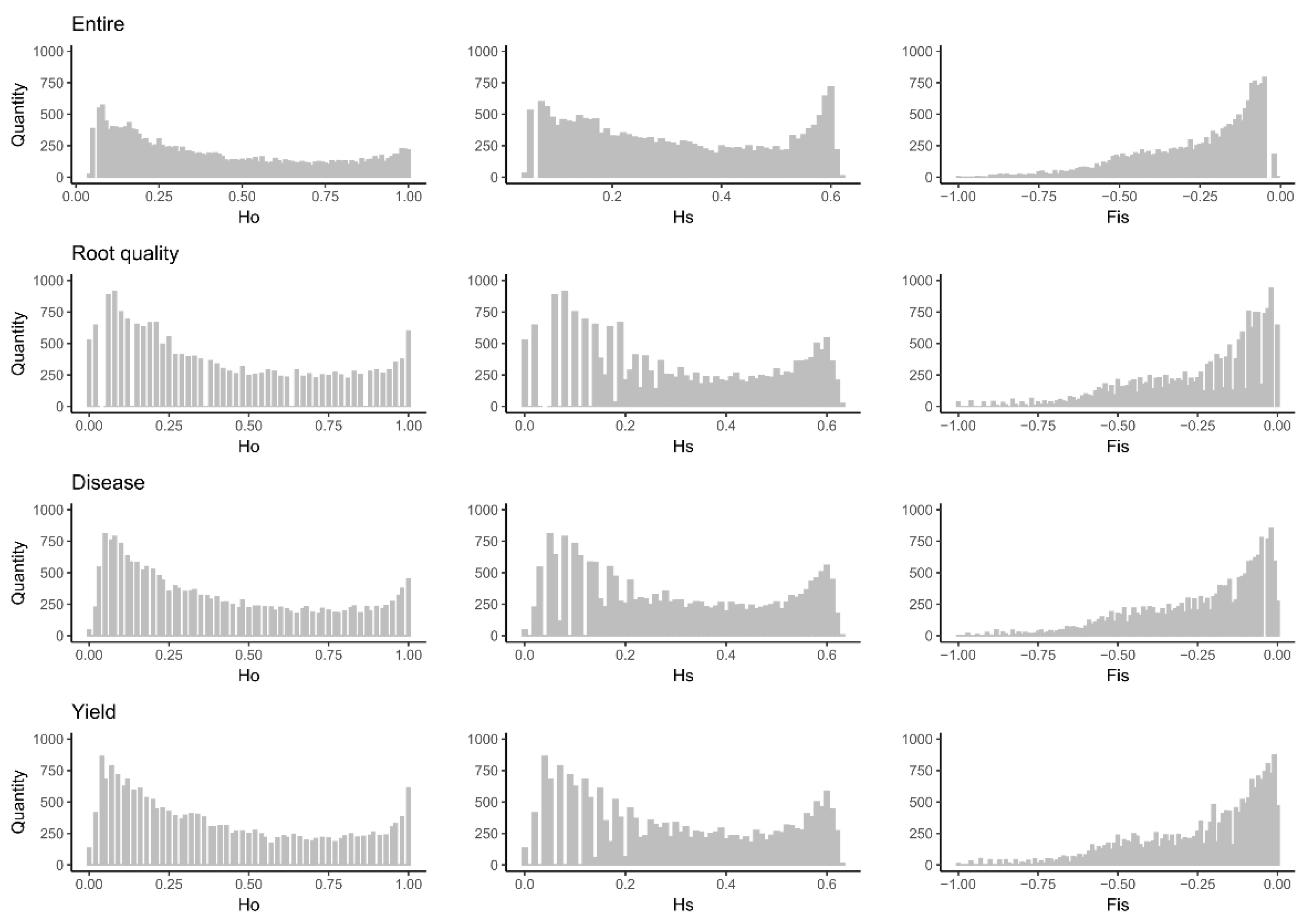
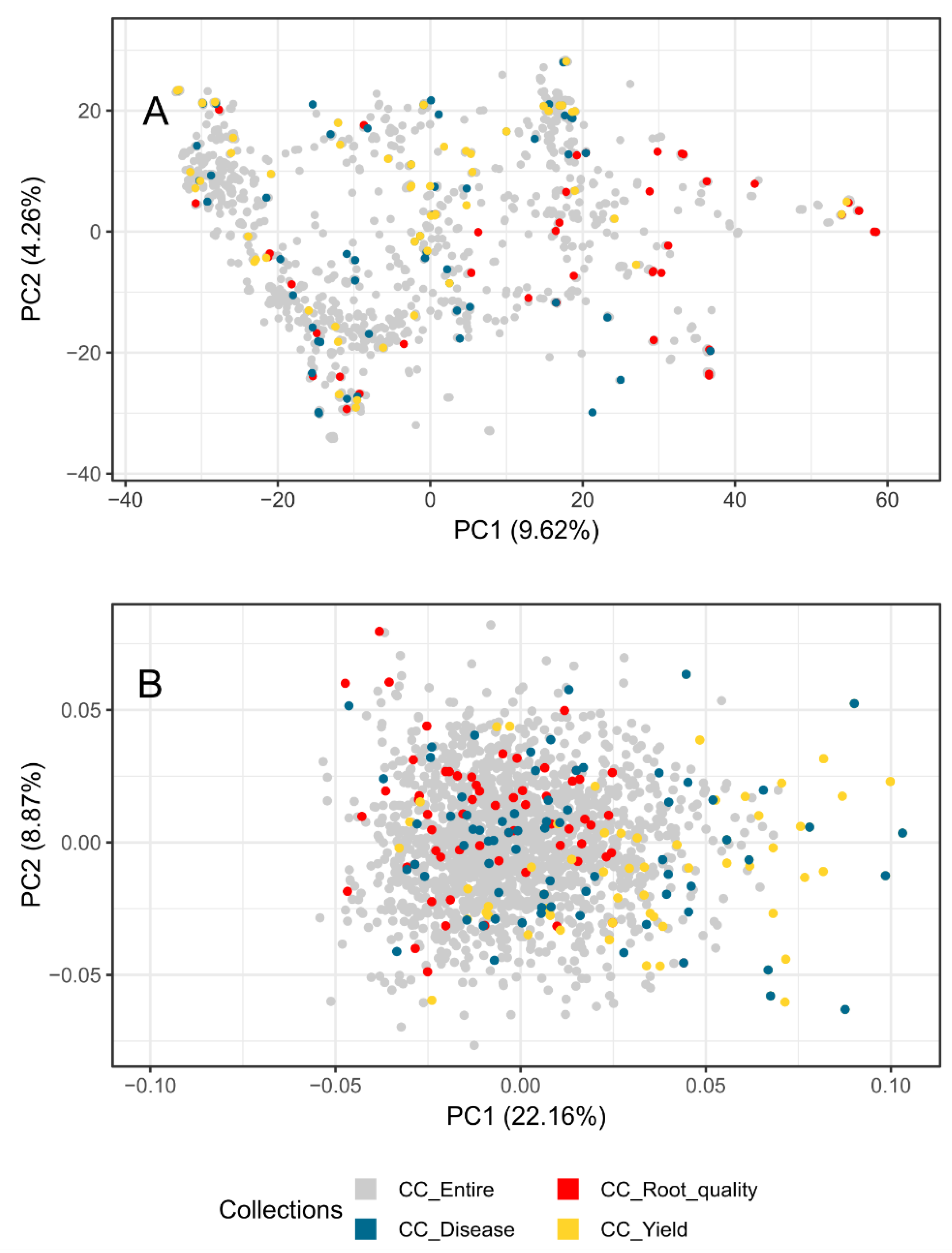
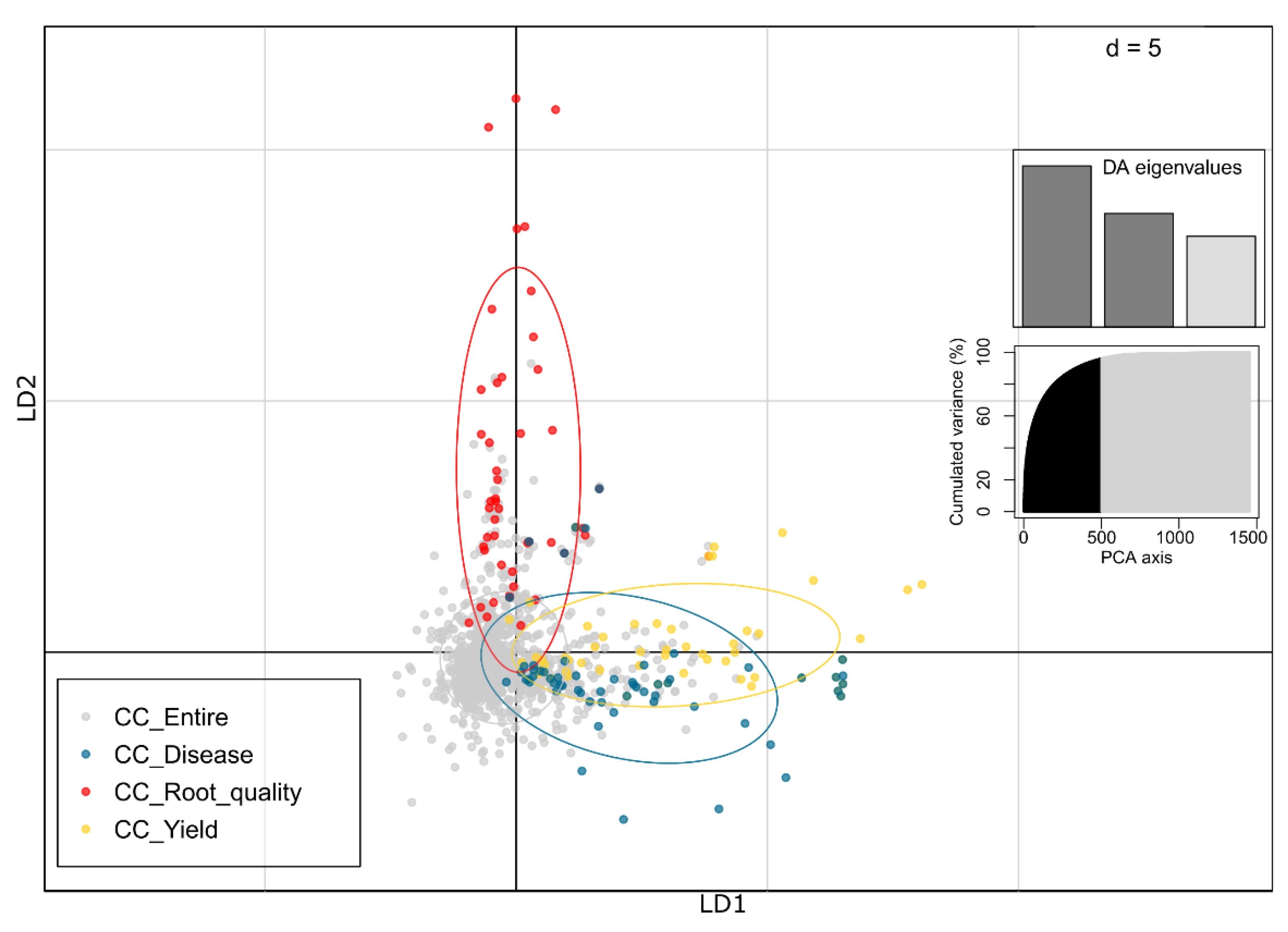
| Kappa Index | CC_Disease * | CC_Root_Quality | CC_Yield |
|---|---|---|---|
| CC_Disease | 1 | 0.096 | 0.176 |
| CC_Root_quality | 0.096 | 1 | 0.110 |
| CC_Yield | 0.176 | 0.110 | 1 |
| Trait * | Collections | Trait | Collections | ||||||
|---|---|---|---|---|---|---|---|---|---|
| CC_Entire | CC_Root_Quality | CC_Yield | CC_Disease | CC_Entire | CC_Root_Quality | CC_Yield | CC_Disease | ||
| Pl.H | 0.73 | 0.63 | 0.78 | 0.77 | D.AntS | 0.73 | 0.75 | 0.65 | 0.84 |
| Pl.A | 0.77 | 0.75 | 0.91 | 0.81 | D.CBB | 0.76 | 0.68 | 0.85 | 0.85 |
| ShY | 0.77 | 0.61 | 0.86 | 0.82 | D.BrLS | 0.76 | 0.73 | 0.62 | 0.93 |
| C.FRY | 0.68 | 0.56 | 0.83 | 0.79 | D.BlLS | 0.53 | 0.48 | 0.50 | 0.46 |
| NC.FRY | 0.61 | 0.61 | 0.85 | 0.67 | D.RS | 0.12 | 0.21 | 0.14 | 0.15 |
| T.FRY | 0.74 | 0.61 | 0.89 | 0.84 | D.FS | 0.37 | 0.40 | 0.30 | 0.31 |
| DRY | 0.77 | 0.65 | 0.89 | 0.87 | D.RRS | 0.11 | 0.10 | 0.24 | 0.24 |
| StC | 0.37 | 0.71 | 0.56 | 0.34 | Ro.HCN | 0.90 | 0.47 | 0.85 | 0.87 |
| HI | 0.75 | 0.65 | 0.64 | 0.73 | Ro_TCC | 0.38 | 0.32 | 0.16 | 0.34 |
| Ro.CT | 0.02 | 0.05 | 0.00 | 0.00 | Pl.T | 0.64 | 0.68 | 0.70 | 0.60 |
| Ro.Le | 0.50 | 0.49 | 0.38 | 0.45 | Ro.Pe | 0.59 | 0.58 | 0.54 | 0.54 |
| Ro.Di | 0.62 | 0.53 | 0.61 | 0.63 | Ro.Co | 0.56 | 0.47 | 0.57 | 0.55 |
| Pl.LR | 0.65 | 0.54 | 0.79 | 0.79 | Ro.EP | 0.45 | 0.34 | 0.42 | 0.35 |
| Pl.V12M | 0.76 | 0.68 | 0.92 | 0.88 | Ro.CC | 0.84 | 0.92 | 0.53 | 0.74 |
| Pl.V1.5M | 0.55 | 0.53 | 0.75 | 0.67 | Ro.SC | 0.63 | 0.41 | 0.51 | 0.63 |
| DMC | 0.66 | 0.77 | 0.69 | 0.64 | Ro.RF | 0.57 | 0.78 | 0.57 | 0.56 |
| Ro.NP | 0.62 | 0.63 | 0.87 | 0.75 | Ro.PC | 0.34 | 0.57 | 0.23 | 0.29 |
| P.MS | 0.73 | 0.75 | 0.74 | 0.78 | Ro.CoT | 0.30 | 0.81 | 0.10 | 0.18 |
| Collections | Observed Heterozygosity (Ho) | Genetic Diversity (Hs) | Inbreeding Coefficient (Fis) | N.º of Alleles | |||
|---|---|---|---|---|---|---|---|
| Mean | Variances | Mean | Variances | Mean | Variances | ||
| CC_Entire | 0.403 | (0.04–1.00) | 0.301 | (0.04–0.62) | 0.228 | (−1.00/ 0.01) | 58,671 |
| CC_Disease | 0.405 | (0.00–1.00) | 0.302 | (0.00–0.63) | −0.227 | (−1.00/ 0.00) | 53,251 |
| CC_Root_quality | 0.394 | (0.00–1.00) | 0.292 | (0.00–0.63) | −0.226 | (−1.00/ 0.00) | 51,688 |
| CC_Yield | 0.410 | (0.00–1.00) | 0.303 | (0.00–0.63) | −0.234 | (−1.00/ 0.00) | 52,211 |
| Phenotypic Class | Lower Limit | Upper Limit |
|---|---|---|
| 1 | ||
| 2 | ||
| 3 | ||
| 4 | ||
| 5 | ||
| 6 |
Disclaimer/Publisher’s Note: The statements, opinions and data contained in all publications are solely those of the individual author(s) and contributor(s) and not of MDPI and/or the editor(s). MDPI and/or the editor(s) disclaim responsibility for any injury to people or property resulting from any ideas, methods, instructions or products referred to in the content. |
© 2023 by the authors. Licensee MDPI, Basel, Switzerland. This article is an open access article distributed under the terms and conditions of the Creative Commons Attribution (CC BY) license (https://creativecommons.org/licenses/by/4.0/).
Share and Cite
dos Santos, C.C.; de Andrade, L.R.B.; do Carmo, C.D.; de Oliveira, E.J. The Development of Thematic Core Collections in Cassava Based on Yield, Disease Resistance, and Root Quality Traits. Plants 2023, 12, 3474. https://doi.org/10.3390/plants12193474
dos Santos CC, de Andrade LRB, do Carmo CD, de Oliveira EJ. The Development of Thematic Core Collections in Cassava Based on Yield, Disease Resistance, and Root Quality Traits. Plants. 2023; 12(19):3474. https://doi.org/10.3390/plants12193474
Chicago/Turabian Styledos Santos, Caroline Cardoso, Luciano Rogerio Braatz de Andrade, Cátia Dias do Carmo, and Eder Jorge de Oliveira. 2023. "The Development of Thematic Core Collections in Cassava Based on Yield, Disease Resistance, and Root Quality Traits" Plants 12, no. 19: 3474. https://doi.org/10.3390/plants12193474
APA Styledos Santos, C. C., de Andrade, L. R. B., do Carmo, C. D., & de Oliveira, E. J. (2023). The Development of Thematic Core Collections in Cassava Based on Yield, Disease Resistance, and Root Quality Traits. Plants, 12(19), 3474. https://doi.org/10.3390/plants12193474






